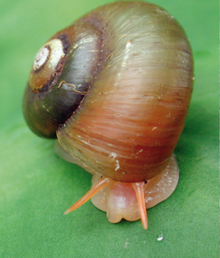Amphicyclotulus amethystinus is a species of tropical land snail with a gill and an operculum, a terrestrial gastropod mollusk in the family Neocyclotidae.
| Amphicyclotulus amethystinus | |
|---|---|

| |
| Amphicyclotulus amethystinus. | |
| Scientific classification | |
| Kingdom: | |
| Phylum: | |
| Class: | |
| (unranked): | |
| Superfamily: | |
| Family: | |
| Genus: | |
| Species: | A. amethystinus
|
| Binomial name | |
| Amphicyclotulus amethystinus | |
| Synonyms[2] | |
| |
Shell description edit
The shell is smooth, shining, not striate spirally, generally somewhat more depressed, deep chestnut or reddish brown. Whorls are a little flattened near the suture.[1] The species may have subtle spiral striation, although there exists considerable variation; axial growth lines are clearly visible.[2]
The operculum is horny, diaphanous, concave externally, cartilaginous within, the nucleus projecting internally; with from ten to fourteen very narrow whorls, their rather lamellar outer edges slightly free.[1]
Amphicyclotulus amethystinus has spiral threads absent or only weakly present.[2] There are found only two species in the genus Amphicyclotulus in Dominica. The other species is Amphicyclotulus dominicensis and it has spiral cords clearly present and raised.[2]
Robert John Lechmere Guppy (1868)[1] noted that this species is not found above 1000 m. Although he recognized two "forms", he did not recognize two separate species. George French Angas (1884)[3] subsequently recorded "Cyclophorus amethystinus" from altitudes above 1200 m. Paul Bartsch (1942)[4] restricted the name amesthystinus to Guppy’s var. β, the "smooth, shining, not striate spirally" form.[2]
Distribution edit
This species is endemic to in Dominica.[2]
The type locality is Laudat, Dominica.[2] The holotype is in National Museum of Natural History under number 535856.[2]
All known localities of Amphicyclotulus amethystinus include:[2]
- Saint Andrew Parish, Dominica: west of Calibishie, Hampstead Estate
- Saint Andrew Parish, Dominica: Carib Territory
- Saint Andrew Parish, Dominica: Marigot, Captain Bruce
- Saint Andrew Parish, Dominica: 1 km northwest of Thibaud
- Saint David Parish, Dominica: Emerald Pool
- Saint David Parish, Dominica: 1.5 km north of Petit Savane
- 0.5 km south of Rosalie River bridge
- Saint George Parish, Dominica: Bellevue Chopin
- Saint George Parish, Dominica: Freshwater Lake area
- Saint George Parish, Dominica: trail to Lake Boeri
- Saint Joseph Parish, Dominica: d’Leau Grommier
- Saint Joseph Parish, Dominica: road to Fond Cassé, Mary Martin Farm
- Saint Joseph Parish, Dominica: path Mero-Salisbury
- Saint Luke Parish, Dominica: Pointe Michel
- Saint Paul Parish, Dominica: Sylvania
- Saint Peter Parish, Dominica: Syndicate.
References edit
This article incorporates CC-BY-3.0 text from the reference [2] and public domain text from the reference.[1]
- ^ a b c d e Guppy R. J. L. (1868). "On the terrestrial mollusks of Dominica and Grenada, with an account of some new species from Trinidad". Annals and Magazine of Natural History (4)1: 429-442.
- ^ a b c d e f g h i j Robinson D. G., Hovestadt A., Fields A. & Breure A. S. H. (July 2009). "The land Mollusca of Dominica (Lesser Antilles), with notes on some enigmatic or rare species". Zoologische Mededelingen 83 http://www.zoologischemededelingen.nl/83/nr03/a13
- ^ Angas G. F. (1884). "On the terrestrial Mollusca of Dominica, collected during a recent visit to that island". Proceedings of the Zoological Society of London 1883: 594-597, figs 1-3.
- ^ Bartsch P. (1942). "The cyclophorid mollusks of the West Indies, exclusive of Cuba": 43-141. In: Torre C. de la, Bartsch P. & Morrison J. P. E. (1942). The cyclophorid operculate land mollusks of America. Bulletin United States National Museum 181: 1-306, pls 1-42.